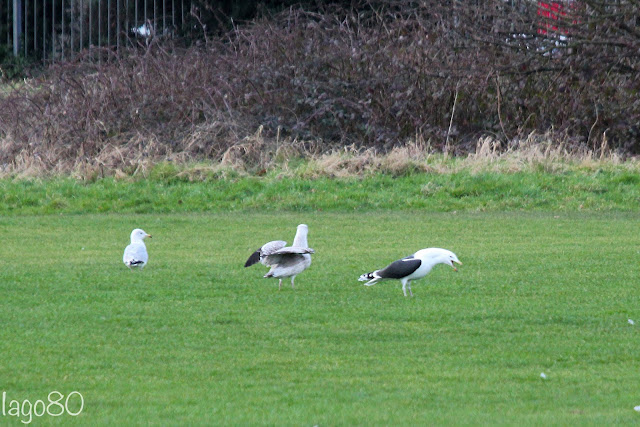During the winter months, you can find several hundred gulls on the Wanstead Flats. The combination of sizeable mown grassland with 50+ football pitches (ideal for foot paddling for worms), a few lakes with ‘beaches’, and regular feedings of industrial quantities of bread must all serve as attractions to gulls. The relative proximity to several huge watery or waste gull magnet sites cannot hurt either.
The numbers of Common Gull present are sizeable enough to be an important site for the species, and counts of 500+ are not unusual.
In second place comes the Black-headed Gull which can also be numbered in the multiple of hundreds.
Herring Gull and Lesser Black-backed Gull are only normally present in small - sometimes single digit - numbers across the Patch.
With the exception of scarce visitors or local rarities (with Yellow-legged Gull and Mediterranean Gull being the most common), the remaining commonly found gull, Great Black-backed Gull, is also effectively a local scarcity. Often only seen a few times in the year as fly-overs.
However, in recent years we have had a regular visiting adult on the Brick Pit field.
I had only briefly seen it once this year from Bob’s car window after twitching the Great White Egret on Perch Pond. So, on Sunday, when I saw a large gull with dark saddle come down in the distance I instantly headed to the field in hope of a decent photograph. Sadly it is easily flushed and did not let me get anywhere near it, so I only managed record shots. But I did manage to capture it with a first winter bird as well.
I know it’s a poor photo but just look at the bull-necked beast with the 1W GBBG and a nervous looking Herring Gull to the left!
If the size of the 1W bird was not enough of a giveaway, the diffuse and narrow tail band and markings, the pale greater coverts, and the nice bright window on the primaries all just about show in this blurry flight-shot (you can hardly blame me for the blur - I had to shoot all of those red ID arrows after it).




No comments:
Post a Comment